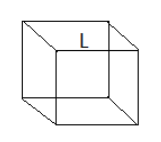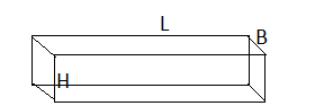
Write the number of faces of the cube and cuboid.
Answer
576.9k+ views
Hint: In order to solve this problem you need to draw the diagram and also need to know that the difference between a cube and cuboid is just that the face of the cube is of squared shape and that of the cuboid can be of square as well as rectangular shape. It means every cube is a cuboid. Knowing this will solve your problem.
Complete step-by-step answer:
Cube - A cube is a three-dimensional solid object bounded by six square faces, facets or sides, with three meeting at each vertex. The cube is the only regular hexahedron and is one of the five Platonic solids. It has 6 faces, 12 edges, and 8 vertices.

Above figure is the figure of the cube of edge length L.
Cuboid - A cuboid is a 3D shape. Cuboids have six faces, which form a convex polyhedron. Broadly, the faces of the cuboid can be any quadrilateral. More narrowly, rectangular cuboids are made from 6 rectangles, which are placed at right angles. A cuboid that uses all square faces is a cube.

It is a cuboid of length L, breadth B and height H.
Difference between Cube and Cuboid: The key difference between cube and cuboid is: a cube has six square-shaped faces of the same size but a cuboid has rectangular faces. Although both cube and cuboid look the same in structure they have a few different properties based on edge-length, diagonals and faces.
Hence, the cube and cuboid both have 6 faces.
Note:To solve such problems you need to draw the diagram and need to know that a Cube is a solid three-dimensional figure, which has 6 square faces, 8 vertices and 12 edges. It is also said to be a regular hexahedron. You must have seen 3 × 3 Rubik’s cubes, which is the most common example in the real-life and it is helpful to enhance brain power. In the same way, you will come across many real-life examples, such as 6 sided dices, etc. and cuboids have rectangular or square faces. Knowing this will solve your problem.
Complete step-by-step answer:
Cube - A cube is a three-dimensional solid object bounded by six square faces, facets or sides, with three meeting at each vertex. The cube is the only regular hexahedron and is one of the five Platonic solids. It has 6 faces, 12 edges, and 8 vertices.

Above figure is the figure of the cube of edge length L.
Cuboid - A cuboid is a 3D shape. Cuboids have six faces, which form a convex polyhedron. Broadly, the faces of the cuboid can be any quadrilateral. More narrowly, rectangular cuboids are made from 6 rectangles, which are placed at right angles. A cuboid that uses all square faces is a cube.

It is a cuboid of length L, breadth B and height H.
Difference between Cube and Cuboid: The key difference between cube and cuboid is: a cube has six square-shaped faces of the same size but a cuboid has rectangular faces. Although both cube and cuboid look the same in structure they have a few different properties based on edge-length, diagonals and faces.
Hence, the cube and cuboid both have 6 faces.
Note:To solve such problems you need to draw the diagram and need to know that a Cube is a solid three-dimensional figure, which has 6 square faces, 8 vertices and 12 edges. It is also said to be a regular hexahedron. You must have seen 3 × 3 Rubik’s cubes, which is the most common example in the real-life and it is helpful to enhance brain power. In the same way, you will come across many real-life examples, such as 6 sided dices, etc. and cuboids have rectangular or square faces. Knowing this will solve your problem.
Recently Updated Pages
Master Class 8 Maths: Engaging Questions & Answers for Success

Class 8 Question and Answer - Your Ultimate Solutions Guide

Master Class 7 Maths: Engaging Questions & Answers for Success

Class 7 Question and Answer - Your Ultimate Solutions Guide

Master Class 6 Maths: Engaging Questions & Answers for Success

Class 6 Question and Answer - Your Ultimate Solutions Guide

Trending doubts
What is BLO What is the full form of BLO class 8 social science CBSE

Which one of the following groups comprises states class 8 social science CBSE

Citizens of India can vote at the age of A 18 years class 8 social science CBSE

Full form of STD, ISD and PCO

A couple went for a picnic They have 5 sons and each class 8 maths CBSE

Right to vote is a AFundamental Right BFundamental class 8 social science CBSE




